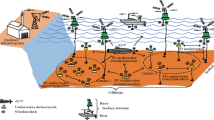Abstract
In a mobile underwater acoustic wireless sensor networks (MUAWSN), one of the most important challenging issues is coverage and connectivity during data transmission. It is very difficult to access and cover the monitoring region due to less coverage in underwater environments. Various algorithms, strategies and mechanisms have been proposed by researchers around the world to solve these problems. A new approach is implemented in mobile underwater acoustic wireless sensor networks to enhance maximum coverage and connectivity of the cluster networks. In our proposed work, random cluster deployment of sensors in MUAWSN is used. The coverage hole problem is realistic in the MUAWSN due to node damage or active node count goes below the threshold limit. An energy prediction algorithm is proposed using Markov Chain Monte Carlo (MCMC) process which enhances the maximum coverage and connectivity during data transmission by analyzing the sample value of known parameter in water surface. The topology gets altered due to water mobility caused by several factors such as waves, winds, currents and network coverage and connectivity performance. In addition, to improve hop-by-hop dynamic address based (HH-DAB) Routing Protocol predicting energy consumption is re-framed as modified hop-by-hop dynamic address based (modified HH-DAB) Routing Protocol in which the random mobility of the node get stretched in 2-D space which leads to maximum coverage and connectivity in 3-D. Theoretical analysis and experimental simulation results are evaluated based on performance metrics such as residual energy consumption (REC), packet delivery ratio (PDR), network coverage ratio (NCR) and Network Lifetime. The results shows that the proposed Modified HH-DAB system has maximum residual energy consumption of 14.28%, maximum increase in packet delivery ratio of 50%, maximum increase in network coverage ratio of 50% and maximum increase in network lifetime of 50%. The results are encouraging and our proposed method is found to be more efficient than the HH-DAB protocol. The proposed protocols of modified HH-DAB mechanism improves coverage, connectivity and network lifetime.






Similar content being viewed by others
Explore related subjects
Discover the latest articles, news and stories from top researchers in related subjects.References
Alves MM, Pirmez L, Rossetto S, Delicato FC, de Farias CM, Pires PF, dos Santos IL, Zomaya AY (2017) Damage prediction for wind turbines using wireless sensor and actuator networks. J Netw Comput Appl 80:123–140
Ayaz M, Abdullah A (2009) Hop-by-hop dynamic addressing based (h2-dab) routing protocol for underwater wireless sensor networks. In: 2009 international conference on information and multimedia technology, IEEE, pp 436–441
Ayaz M, Baig I, Abdullah A, Faye I (2011) A survey on routing techniques in underwater wireless sensor networks. J Netw Comput Appl 34(6):1908–1927
Balister P, Kumar S (2009) Random vs. deterministic deployment of sensors in the presence of failures and placement errors. In: IEEE INFOCOM 2009, IEEE, pp 2896–2900
Gkikopouli A, Nikolakopoulos G, Manesis S (2012) A survey on underwater wireless sensor networks and applications. In: Control & Automation (MED), 2012 20th Mediterranean Conference on, IEEE, pp 1147–1154
Khan MU, Feroze S, Zia M (2016) Coverage control algorithm for node scheduling in wireless sensor networks. In: Frontiers of Information Technology (FIT), 2016 International Conference on, IEEE, pp 17–22
Kosar R, Bojaxhiu I, Onur E, Ersoy C (2011) Lifetime extension for surveillance wireless sensor networks with intelligent redeployment. J Netw Comput Appl 34(6):1784–1793
Li J, Andrew L, Foh C, Zukerman M, Chen HH (2009) Connectivity, coverage and placement in wireless sensor networks. Sensors 9(10):7664–7693
Luo J, Hu J, Wu D, Li R (2015) Opportunistic routing algorithm for relay node selection in wireless sensor networks. IEEE Trans Ind Inf 11(1):112–121
Nam H, An S (2008) Energy-efficient routing protocol in underwater acoustic sensor networks. In: Embedded and Ubiquitous Computing, 2008. EUC’08. IEEE/IFIP International Conference on, IEEE, vol 2, pp 663–669
Priyadarshini RR, Sivakumar N (2018) Cluster head selection based on minimum connected dominating set and bi-partite inspired methodology for energy conservation in wsns. Journal of King Saud University-Computer and Information Sciences
Sandeep D, Kumar V (2017) Review on clustering, coverage and connectivity in underwater wireless sensor networks: a communication techniques perspective. IEEE Access 5:11176–11199
Shi HY, Wang WL, Kwok NM, Chen SY (2012) Game theory for wireless sensor networks: a survey. Sensors 12(7):9055–9097
Wang Z, Wang B (2017) A novel node sinking algorithm for 3D coverage and connectivity in underwater sensor networks. Ad Hoc Netw 56:43–55
Yang CH, Ssu KF (2008) An energy-efficient routing protocol in underwater sensor networks. In: Sensing Technology, 2008. ICST 2008. 3rd International Conference on, IEEE, pp 114–118
Yildiz HU, Gungor VC, Tavli B (2019) Packet size optimization for lifetime maximization in underwater acoustic sensor networks. IEEE Trans Ind Inf 15(2):719–729
Zhang H, Hou JC (2005) Is deterministic deployment worse than random deployment for wireless sensor networks? Tech. rep
Author information
Authors and Affiliations
Corresponding author
Additional information
Publisher's Note
Springer Nature remains neutral with regard to jurisdictional claims in published maps and institutional affiliations.
Rights and permissions
About this article
Cite this article
Raj Priyadarshini, R., Sivakumar, N. Enhancing coverage and connectivity using energy prediction method in underwater acoustic WSN. J Ambient Intell Human Comput 11, 2751–2760 (2020). https://doi.org/10.1007/s12652-019-01334-x
Received:
Accepted:
Published:
Issue Date:
DOI: https://doi.org/10.1007/s12652-019-01334-x




